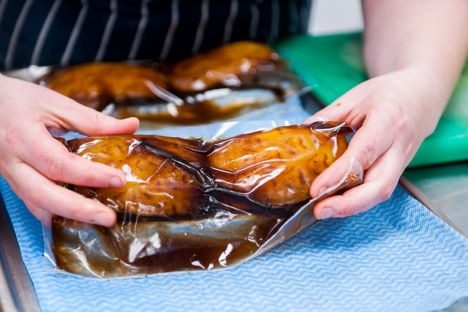
Top tips for sous vide cooking
With vacuums, precise temperatures and lots of complicated-sounding kit, sous vide can seem like the stuff of science fiction. In reality, it’s an incredibly simple method that produces outstanding results – these handy tips cover all the bases while you get to grips with your new equipment.
Top tips for sous vide cooking
With vacuums, precise temperatures and lots of complicated-sounding kit, sous vide can seem like the stuff of science fiction. In reality, it’s an incredibly simple method that produces outstanding results – these handy tips cover all the bases while you get to grips with your new equipment.
Sous vide can seem a little daunting at first, but once you master a basic understanding of how low temperature cooking works it’s actually pretty straightforward. The best way to learn is to experiment with different foods, times and temperatures. Here we give you a few extra hints and ideas to help you along the way.
Mighty meats
Cooking meat in a bag may seem unconventional, but this simple technique allows flavour to be locked in and takes away the risk of charred disasters or that raw-in-the-middle panic. Our chefs have shown that you can cook virtually any meat to perfection using a sous vide; from succulent sirloin to slow-cooked ox tongue, tender spring lamb to festive turkey, every size of bird from pigeon to duck and all other types of glorious game. Whether it’s a bang on trend sous vide goat shoulder or just a simple chicken breast, meat, poultry and game benefits amazingly from the gentle cooking of sous vide.
Add a little oil when cooking meat to help it retain its natural shape.
For perfectly cooked chicken and duck, cook the crown and legs separately to get the best out of both.
For time-saving meals, cook batches of meat at a time and chill down in iced water before freezing. To reheat, simply place in a 55°C water bath after defrosting.
Flaky fish
Often a chef's nightmare, delicate fish is easy to overcook, resulting in tough fillets or rubbery seafood. Compounding the stress, seafood is usually cooked at the very last minute before serving, leaving no margin for error and hungry diners waiting at the table. Enter the water bath – slow, gentle cooking ensures that no fish is overdone, yet tougher cuts, such as octopus, get the long cooking time they need and there's no last minute fretting to ensure it's cooked through. Although cooking salmon sous vide is one of the most popular options, the whole ocean is up for grabs – cod, halibut and meaty monkfish, perhaps a delicate Dover sole, or push the boat out with lobster, scallops, crab and king prawns.
Cook portions of fish with the skin on to hold it together, then remove after.
If a piece of fish is too fragile to pan-fry after cooking, try blowtorching instead.
Bar sealers are not normally suited to liquid marinades or poaching liquors, but if you freeze the liquid first, then you can seal in the bag as a solid using the bar sealer at home.
Vibrant veg
Keeping beautiful vegetables from turning into a generic mush can be tricky and takes away from the appeal of wonderful fresh produce. Sous vide cooking can help retain the colour, shape and unique flavours of individual vegetables, whether used to cook slowly in a water bath, to pickle or infuse or just to compress with the vacuum. Showing off their creativity, our chefs have cooked earthy roots such as beetroot, potatoes and carrots sous vide, or enhanced the British summer classics of cucumbers, radishes and tomatoes.
Using vac-pac bags in the microwave is a nifty way to quickly cook small onions such as grilottes; simply place in individual bags, seal and microwave for 30 seconds or so and the onion will steam itself and cook.
If you want a flavour-packed, brightly coloured purée, cook long and slow in sous vide as there's no risk of burning or drying out.
Sous vide is great for pickling – it speeds up the process and requires less liquid than conventional methods.
Decadent desserts
Not just the domain of mains, many sweets can be cooked sous vide. Infused fruits can be cooked or compressed just like vegetables, retaining their natural shapes, flavours and colours, while the water bath can replicate a bain-marie cooking technique for cream-based recipes. Improve your recipe for poached pears with sous vide cooking, or create the perfect sticky, honey-glazed figs. Get creative with the caramel flavour of bananas or tropical pineapple, and preserve the taste of summer with delicious macerated strawberries.
The water bath is a useful tool for tempering chocolate, as the temperature can be accurately controlled throughout and there is little risk of the chocolate seizing.
Making custards and crème brûlée sous vide is hassle-free and gives an incredibly silky, smooth result.
Avoid burnt pans and a sticky mess by cooking condensed milk sous vide for the ultimate dulce de leche toffee.

